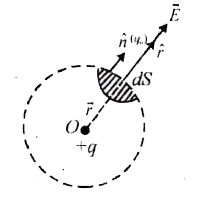Deduce Coulomb's law from Gauss's theorem in electrostatics.
Text Solution
consider a point charge + at O. Imagine a sphere of radius r and with centre O. The angle between →E and →dS is zero (0°). According to Gauss.s law,
ΦE=∮→E.−→dS=qɛ0 ⇒∮EdScos0∘=qɛ0
⇒ ∮E.dS=qɛ0
But ∮dS=4πr2
⇒ E.4πr2=qɛ0 [∴ ∫dS=4πr2]
⇒ E=q4πr2ɛ0 ⇒ E=14πɛ0.qr2.
From definition of electric field intensity E=Fq0
⇒ Fq0=14πɛ0.qr2⇒F=14πɛ0. . This is Coulomb.s law.
Expression for electric field when sheet is thick:
In case of a sheet, with finite thickness, both sides of the sheet are to be considered.
∴ from equation (i), we get
∮→E.−→dS=2σSɛ0
or 2ES=2σSɛ0
or E=σɛ0 ......(v)

|
Similar Questions
Knowledge Check
What is the nature of Gaussian surface involved in Gauss's law of electrostatics?
AScalarBElectricalCMagneticDVector
State and prove Gauss's law in electrostatics.
View SolutionState and prove Gauss's law in electrostatics.
View SolutionState the limitation of Coulomb's law in electrostatics.
View SolutionState Gauss's theorem in electrostatics. Apply this theorem to derive an expression for electric field intensity at a point outside a uniformly charged thin spherical shell.
View SolutionCoulomb Law Of Electrostatics
View SolutionState Coulomb's law of force in electrostatics. Express it in vector form.
View SolutionWhat is the nature of Gaussian surface involved in Gauss's law of electrostatics?
View Solution
